"The aim of Zionism in the erection for the Jewish people of a publicly recognised, legally secured home in Palestine. Not a Jewish State". President of the 10th Zionist Congress, Basle 1911.
The Concept of Transfer
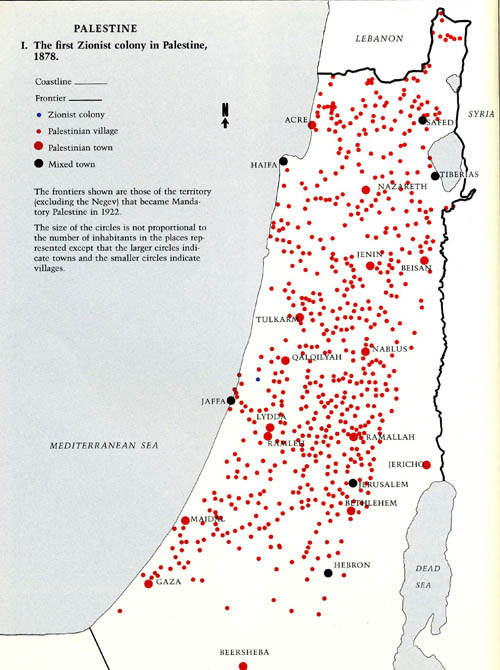
With Palestinian riots erupting in 1936, Britain decided to dispatch a commission to investigate the causes for the riots and the clashes taking place between Jews and Arabs. The Royal Commission, known as the Royal (Peel) Commission arrived in Palestine in November of that year led by William W Peel, 1st Earl Peel (1867-1937). It interviewed Zionist and Arab leaders before it made its recommendations suggesting in a nut shell that “sooner or later, there should be a transfer of land and, as far as possible, an exchange of population”.
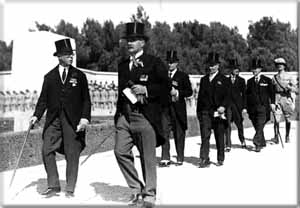 Lord Peel arriving in Mandate Palestine, November 1936
Lord Peel arriving in Mandate Palestine, November 1936
The Commission’s recommendations were seen as the first official indication of a plan to partition Palestine and to transfer its population, an idea credited to one of the Peel Commission members, Reginald Couplan, who was considered Zionism’s greatest friend on the Royal Commission. But contrary to general belief, the idea of partition did not occur in the Commission's mind until after its members had left Palestine and after its 396-page Report had been written. For the first time in any government document, it was stated that the existing mandate for Palestine was unworkable and that the aspirations of Arabs and Jews were irreconcilable. Yet the Commision's Report was enthusiastically received by a powerful group called The Milner Group (see next section) and was accepted as policy.
So the transfer concept was slowly tied to the idea of partitioning and became the central core of all Zionist lobbying efforts that followed.
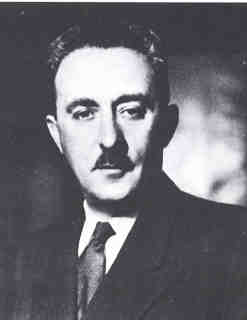 Moshe Shertok (1894-1965), who, like Jabotinsky, was born in the Ukraine, (and later became the 2nd Prime Minister of Israel), was elected as the head of the political department of the Jewish Agency. He was crucial in formulating policies on the question of transfer. In a speech to the Zionist Actions Committee in April 1937, he stated:
Moshe Shertok (1894-1965), who, like Jabotinsky, was born in the Ukraine, (and later became the 2nd Prime Minister of Israel), was elected as the head of the political department of the Jewish Agency. He was crucial in formulating policies on the question of transfer. In a speech to the Zionist Actions Committee in April 1937, he stated:
“The proposed Jewish state would not be continuous. The frontier line would separate villages from their fields…the Arab reaction would be negative [to the partition idea] because they would loose everything and gain almost nothing…they would loose the richest part of Palestine…the orange plantations, the commercial and industrial centres…most of the coastal areas…and [they] would be driven out into the desert. As for now, we must not forget who would have to exchange the land? Those villagers who live more than others on irrigation, on orange and fruit plantations, in houses built near water wells and pumping stations, on livestock and property and easy access to markets. Where would they go? What would they receive in return? This would be such an uprooting, such a shock the likes of which had never occurred before and could drown the whole thing in rivers of blood”.
This revealing speech, could have been made today as it would reflect exactly what is happening to the Palestinian territories now. The fear amongst the Palestinian people was that the Peel Commission was taking one step towards turning the Balfour Declaration of a ‘Jewish National Home’ into a Jewish State.
Although Ben-Gurion admitted that he could forsee enormous difficulties “in uprooting by foreign force some 100,000 Arabs from the villages in Galilee which they have inhabited for hundreds of years”, he was, nevertheless, determined that “we must be prepared to carry out the transfer…we must expel Arabs and take their place, and if we have to use force…the we have force at our disposal…Our strength will exceed theirs [the Arabs] and we will be better organised and equipped because behind us still stands…the whole younger generation of Jews from Europe and America”.
This is from a terrorist who became the first Prime Minister of Israel.
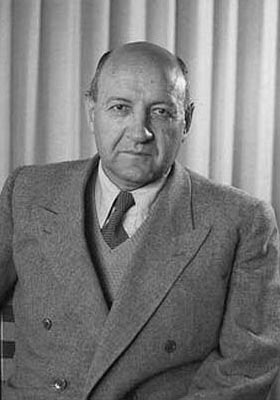
Eliezer Kaplan (1891-1952), born in Minsk, Belurussia, was appointed head of the Finance and Administrative Department of the Jewish Executive (and later became the Finance Minister in Ben-Gurion government). He declared that “the question here is not one of expulsion, but of organised transfer from Jewish territories to another place”.
Other Zionist leaders were even worried that such a transfer to neighbouring countries would actually jeopardize future expansion of the Jewish state [into these neighbouring countries]!
One of the leaders of the Mapai Party, Yosef Baratz (1890-1968), born in the Ukraine but moved to Palestine against his parents’ wishes, was initially doubtful whether it would be possible to transfer 300,000 Palestinian Arabs. Yet, he confidently remembered that: “…dind’t we transfer Arabs from D’Aganiya [the first Zionist communal settlement in Palestine where he lived and married] , Kenert, Merhavya and Mishmar Haemek? I remember the nights on which Shmuel Dayan [Moshe Dayan’s father] and I were called to help Hashomer [a Zionist terrorist organization] carry out Arab evacuation. What was the sin in that?”.
 Moshe Dayan (1915-1981) was born in a kibbutz to Jewish immigrants from the Ukraine. He later became Israel’s defense minister between 1953-1958. He spoke of the effect of the Zionist transfer policy on the Palestinian landscape [as quoted in Haaretz in April 1969]: Jewish villages were built in the place of Arab villages [in Palestine]. You do not even know the names of these Arab villages, and I do not blame you because geography books no longer exist; not only do the books not exist, the Arab villages are not either. Nahlal [Dayan’s own settlement] arose in the place of Mahlool; Kibbutz Gvat in the place of Jibta; Kibbutz Sarid in the place of Huneifis; Kefar Yehushu’a in the place of Tal Al-Shuman. There is not one single place in this country [Israel] that did not have a former Arab population”.
Moshe Dayan (1915-1981) was born in a kibbutz to Jewish immigrants from the Ukraine. He later became Israel’s defense minister between 1953-1958. He spoke of the effect of the Zionist transfer policy on the Palestinian landscape [as quoted in Haaretz in April 1969]: Jewish villages were built in the place of Arab villages [in Palestine]. You do not even know the names of these Arab villages, and I do not blame you because geography books no longer exist; not only do the books not exist, the Arab villages are not either. Nahlal [Dayan’s own settlement] arose in the place of Mahlool; Kibbutz Gvat in the place of Jibta; Kibbutz Sarid in the place of Huneifis; Kefar Yehushu’a in the place of Tal Al-Shuman. There is not one single place in this country [Israel] that did not have a former Arab population”.
The records of the Protocol of the 20th Zionist Congress on 9 August 1937, show that the idea of transfer was heavily debated: “in Dr Weizman’s opinion, it would be possible to transfer 100,000 Palestinians in 20 years, i.e., 5,000 per year. He [Weizmann] told of a plan to set up a fund for a large [Arab] re-settlement. The Jews will contribute to this the amount of 1 million Palestinian pounds, and another 2 million pounds will be given…from the savings of the Mandatory treasury”.
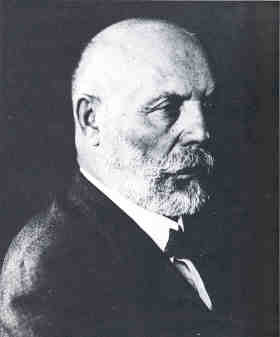 Menachem Ussishkin (1863-1941), born in Imperial Russia and elected chairman of the powerful and influential Jewish National Fund, advocated the transfer of Palestinians not only to Transjordan, but to Iraq [the farther the better, he apparently thought]: “the Arab people in Palestine have immense areas of land at their disposal. Our people have nothing. We demand that our inheritance, Palestine, be returned to us”.
Menachem Ussishkin (1863-1941), born in Imperial Russia and elected chairman of the powerful and influential Jewish National Fund, advocated the transfer of Palestinians not only to Transjordan, but to Iraq [the farther the better, he apparently thought]: “the Arab people in Palestine have immense areas of land at their disposal. Our people have nothing. We demand that our inheritance, Palestine, be returned to us”.
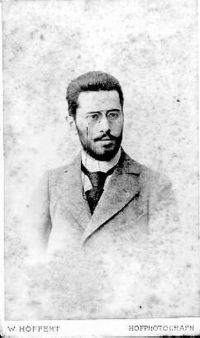 Dr Selig Soskinnother character, Dr Selig Soskin (1872-1959), Director of the Land Settlement Department of the Jewish National Fund, had extensive knowledge of land issues and means of transferring people form one place to another. He advocated the idea of total transfer of Palestinians as a condition for the establishment of a Jewish state. With the help of the Land Fund set up to purchase Arab land, he argued that the transfer must be carried out with the greatest speed possible: “The transfer of the Arabs by such numbers in a long period shall not have the desired effect of freeing the country from the heavy burden of a second class citizen and from cheap producers. Besides, the small numbers suggested by the Peel Commission will be made up by the natural increase in numbers through their economic development under Jewish rule”. He estimated that 40,000 Palestinian families or 250,000 Palestinian Arabs will have to be transferred from the proposed Jewish state. The cost of this transfer, he estimated, would be about £P200 per Arab family.
Dr Selig Soskinnother character, Dr Selig Soskin (1872-1959), Director of the Land Settlement Department of the Jewish National Fund, had extensive knowledge of land issues and means of transferring people form one place to another. He advocated the idea of total transfer of Palestinians as a condition for the establishment of a Jewish state. With the help of the Land Fund set up to purchase Arab land, he argued that the transfer must be carried out with the greatest speed possible: “The transfer of the Arabs by such numbers in a long period shall not have the desired effect of freeing the country from the heavy burden of a second class citizen and from cheap producers. Besides, the small numbers suggested by the Peel Commission will be made up by the natural increase in numbers through their economic development under Jewish rule”. He estimated that 40,000 Palestinian families or 250,000 Palestinian Arabs will have to be transferred from the proposed Jewish state. The cost of this transfer, he estimated, would be about £P200 per Arab family.